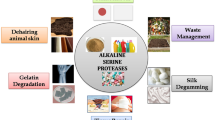Abstract
For the optical resolution of racemic 1-phenylethylamine in 3-methyl-3-pentanol, subtilisin was reformulated by lyophilization with buffer salts. The amide synthesis activity of subtilisin in organic solvent was compared with the hydrolysis activity in aqueous buffer when different buffer species and their concentrations were used in lyophilization. The enzyme activity in organic solvent showed a different pattern from that of the hydrolysis depending upon the species and the concentrations of buffers. Morphology of the reformulated subtilisin was examined by scanning electron microscopy (SEM). The porosity of reformulated subtilisin particles increased up to the optimal buffer concentrations for the amide synthesis in organic solvent. Glassy looks and decrease in porosity developed at high (i.e. above the optimal) buffer concentrations appear to affect the decrease in the synthetic activity in organic media.
Similar content being viewed by others
References
Fersht, A (1985) The pH dependence of enzyme catalysis. p. 155–175 In: A. Fersht (ed.)Enzyme structure and mechanism. Freeman, New York, NY.
Yang, Z., D. Zacherl, and A. J. Russell (1993) pH Dependence of subtilisin dispersed in organic solvents.J. Am. Chem. Soc. 115: 12251–12257.
Amaya, C. L., D. Stubbs, and A. G. Marangoni (1995) A new assay for lipase activity in organic solvents. Lipase-catalyzed synthesis of octyllinolenate in a hexane microaqueous reaction system.Enzyme Microb. Technol. 17: 131–135.
Khmelnitsky, Y. L., S. H. Welch, D. S. Clark, and J. S. Dordick (1994) Salts dramatically enhance activity of enzymes suspended in organic solvents.J. Am. Chem. Soc. 116: 2647–2648.
Otamiri, M., P. Adlercreutz, and B. Mattiasson (1994) Polymer-polymer organic solvent two-phase system for bioorganic synthesis.Biotechnol. Bioeng. 43: 987–994.
Otamiri, M., P. Adlercreutz, and B. Mattiasson (1994) A differential scanning calorimetric study of chymotrypsin in the presence of added polymers.Biotechnol. Bioeng. 44: 73–78.
Wehtje, E., P. Adlercreutz, and B. Mattiasson (1993) Improved activity retention of enzymes deposited on solid supports.Biotechnol. Bioeng. 41: 171–178.
Adlerereutz, P. (1991) On the importance of the support material for enzymatic synthesis in organic media.Eur. J. Biochem. 199: 609–614.
Adlercreutz, P. (1992) On the importance of the support material for enzymatic synthesis in organic media. Support effects at controlled water activity. p. 55–61. In: J. Tramper, M. H. Vermue, H. H. Beeftink, and U. von Stockar (ed.),Biocatalysis in Non-Conventional Media, Elsevier, Amsterdam.
Sears, P., M. Schuster, P. Wang, K. Witte, and C.-H. Wong (1994) Engineering subtilisin for peptide coupling: Studies on the effects of counterions and site-specific modifications on the stability and specificity of the enzyme.J. Am. Chem. Soc. 116: 6521–6530.
Dabulis, K. and A. M. Klibanov (1993) Dramatic enhancement of enzymatic activity in organic solvents by lyoprotectants.Biotechnol. Bioeng. 41: 566–571.
Franks, F. and R. H. M. Hatley (1993) Stable enzymes by water removal. p. 45–54. In: W. J. J. van den Tweel, A. Harder, and R. M. Buitelaar (ed.)Stability and stabilization of enzymes. Elsevier, New York, NY.
Pikal, M. J. (1990) Freeze-drying of proteins. Part I: Process design.BioPharm 9: 18–27.
Pikal, M. J. (1990) Freeze-drying of proteins. Part II: Formulation selection.BioPharm 10: 26–30.
Zaks, A. and A. M. Klibanov (1985) Enzyme-catalyzed processes in organic solvents.Proc. Natl. Acad. Sci. USA. 82: 3192–3196.
Skrika-Alexopoulos, E. and R. B. Freedman (1993) Factors affecting enzyme characteristics of Bilirubin oxidase suspensions in organic solvents.Biotechnol. Bioeng. 41: 887–893.
Kang, B.-Y. and B. G. Kim (1994) Optimization of the optical resolution of racemic α-methylbenzylamine catalyzed by enzymatic reaction in organic media.Korean J. Biotechnol. Bioeng. 9: 306–311.
Kim, J. and B. G. Kim (1996) Effect of the hydration state of supports before lyophilization on subtilisin-A activity in organic media.Biotechnol. Bioeng. 50: 687–692.
Chen, C.-S., Y. Fujimoto, G. Girdaukas, and C. J. Sih (1982) Quantitative analyses of biochemical kinetic resolutions.J. Am. Chem. Soc. 104: 7294–7299.
Kamat, S., E. J. Beckman, and A. J. Russell (1992) Role of diffusion in nonaqueous enzymology: 1. Theory.Enzyme Microb. Technol. 14: 265–271.
Roziewski, K. and A. J. Russell (1992) Effect of hydration on the morphology of enzyme powder.Biotechnol. Bioeng. 39: 1171–1175.
Chang, B. S. and C. S. Randall (1992) Use of subambient thermal analysis to optimize protein lyophilization.Cryobiology 29: 632–656.
Author information
Authors and Affiliations
Corresponding author
Rights and permissions
About this article
Cite this article
Kim, J., Kang, BY. & Kim, BG. The effects of reformulating buffer species and their concentrations on subtilisin-catalyzed optical resolution of racemic 1-phenylethylamine in 3-methyl-3-pentanol. Biotechnol. Bioprocess Eng. 2, 43–47 (1997). https://doi.org/10.1007/BF02932462
Issue Date:
DOI: https://doi.org/10.1007/BF02932462




